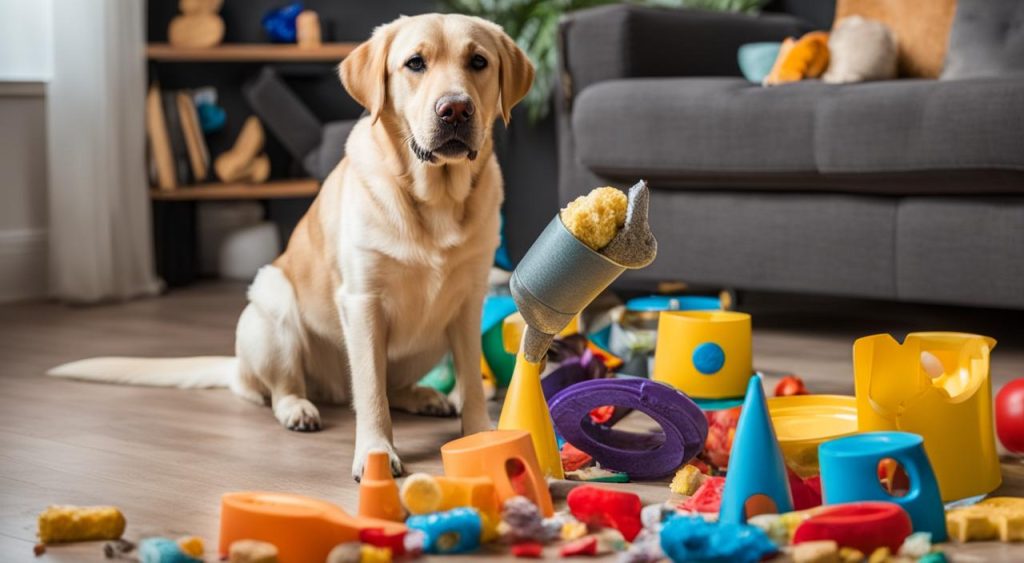Many pet parents find themselves in a situation where they need to leave their Labrador retriever alone for periods of time. While some dogs may adapt well to being alone, others may struggle with the transition. Labrador Retrievers are known for their sociability and close bond with their human families, which can make leaving them alone challenging. However, with proper preparation and care, it is possible to ensure that your Labrador can handle solitude and has their exercise and companionship needs met even when left alone for extended periods of time.
Key Takeaways:
- Leaving Labs alone requires careful consideration of their breed characteristics and temperaments.
- Proper training and socialization can help labs be comfortable and independent when left alone.
- Puppies have limited bladder control and should not be left alone for extended periods.
- Labs need sufficient exercise and mental stimulation when left alone to prevent boredom and destructive behavior.
- Creating a safe and cozy space and providing access to a bathroom area can help prepare Labs for alone time.
Factors to Consider When Leaving Labs Alone
Leaving a Labrador Retriever alone requires careful consideration of various factors. Labrador Retrievers are a sociable breed that thrives on human companionship, making their independence levels vary from dog to dog. It is essential to understand the breed characteristics and temperaments of Labs to assess their ability to handle alone time. Proper training and socialization can play a crucial role in teaching labs to be comfortable and independent when left alone.
Guidelines for Leaving Labs Alone
When leaving a Labrador alone, it is important to establish guidelines to ensure their well-being and happiness. Puppies have limited bladder control and should not be left alone for extended periods. As they grow older, Labs can handle being alone for longer durations, but it is essential to provide them with sufficient exercise and mental stimulation to prevent boredom and destructive behavior.
Creating a safe and cozy space for them, providing access to a bathroom area, and offering mental stimulation through interactive toys are some ways to prepare Labs for being left alone. By setting up a designated area with comfortable bedding and familiar items, labs will feel secure in their own space while you’re away. Making sure they have access to a bathroom area, whether through a doggy door or puppy pads, ensures their physical needs are met even when you’re not there.
“Providing labrador retrievers with mental stimulation is crucial when leaving them alone. Interactive toys, such as treat puzzles or Kong toys stuffed with peanut butter, can engage their minds and keep them entertained for hours.”
In addition to toys, labs also require regular exercise to stay happy and healthy. Taking them for walks, runs, or engaging in active play sessions before leaving can help expend their energy and reduce anxiety. Labs are known for their love of water, so swimming or retrieving balls in the water can be a great way to provide exercise while keeping them cool during hot weather.
“Hiring a dog walker or sitter, enrolling them in daycare, or utilizing professional dog care services can also help meet their social and exercise needs when you’re unable to be with them.”
If you have a busy schedule or need to be away for longer periods, consider hiring a reliable dog walker or sitter who can give your lab the exercise and companionship they need. Doggy daycare facilities can also be a great option, as they provide a structured environment with playtime and socialization opportunities. Professional dog care services can offer peace of mind by ensuring that your lab receives the attention and exercise they require even when you’re not available.
By following these guidelines, you can confidently leave your lab alone knowing that they have a secure and stimulating environment in your absence. Remember to assess your lab’s individual needs and adjust the guidelines accordingly to ensure their well-being and happiness.
Conclusion
Labrador Retrievers, known for their sociability and close bond with their human families, can be left alone for reasonable periods with proper training, preparation, and care. Understanding the needs and temperament of your specific Lab is crucial for ensuring their well-being and happiness during alone time.
Providing your Lab with companionship, mental stimulation, and physical exercise is essential. This can help alleviate any stress or anxiety they may experience when left alone. Each Lab is unique, so it’s important to assess their individual needs and make informed decisions regarding their alone time.
Remember, maintaining a safe and comfortable space for your Lab, providing access to a bathroom area, and offering interactive toys can help them stay entertained and occupied. Additionally, considering options such as hiring a dog walker or sitter, enrolling them in daycare, or utilizing professional dog care services can help meet their social and exercise needs.
By following these guidelines and ensuring your Lab’s well-being, you can leave them alone for appropriate durations while also strengthening the bond you share. With the right approach, your Lab can thrive and be content even when left alone.





